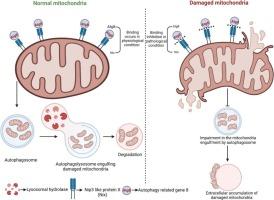BNIP3L/NIX-mediated mitophagy: Future directions in Alzheimer’s disease
IF 2.6
4区 医学
Q3 NEUROSCIENCES
引用次数: 0
Abstract
BCL2-interacting protein 3 like (BNIP3L) /Nip3-like protein X (NIX) is a mitochondrial outer membrane protein possessing mitophagic and pro-apoptotic properties. Mitochondrial dysfunction and subsequent mitophagy impairment are some of the early triggers for Alzheimer’s Disease (AD), which is a progressive neurodegenerative condition affecting memory, thinking, and behavior. AD is associated with mitochondrial protein impairment and mitophagy failure. A recent study showed downregulation in BNIP3L expression in response to stress hormone release during Alzheimer’s, and pretreatment with a BNIP3L enhancer of a corticosterone-exposed mouse upregulated mitophagy. This research proved that BNIP3L stimulation can be an effective therapeutic strategy against Alzheimer’s. However, BNIP3L-mediated mitophagy studies focused on Alzheimer’s have been relatively scarce, and expanding knowledge on its regulatory proteins will help lay a smoother road ahead for future Alzheimer’s research. In this review, we aim to summarize all the recent findings of the downstream proteins of BNIP3L, which play an indispensable role in inducing BNIP3L-mediated mitophagy effects. The review also explicates the significance of healthy mitochondria and normally functioning mitophagy in Alzheimer’s. Finally, the review states the implications of BNIP3L in other diseases, like cardiovascular conditions and cancer, underscoring the immense potential of this wonder protein.

BNIP3L/ nix介导的线粒体自噬:阿尔茨海默病的未来方向
bcl2相互作用蛋白3样(BNIP3L) / nip3样蛋白 X (NIX)是一种线粒体外膜蛋白,具有自噬和促凋亡特性。线粒体功能障碍和随后的线粒体自噬损伤是阿尔茨海默病(AD)的一些早期触发因素,这是一种影响记忆、思维和行为的进行性神经退行性疾病。AD与线粒体蛋白损伤和线粒体自噬失败有关。最近的一项研究表明,在阿尔茨海默氏症期间,BNIP3L表达下调是对应激激素释放的反应,预处理暴露于皮质酮的小鼠BNIP3L增强剂可上调线粒体自噬。本研究证明,BNIP3L刺激可作为治疗阿尔茨海默病的有效策略。然而,针对阿尔茨海默病的bnip3l介导的线粒体自噬研究相对较少,扩大对其调节蛋白的了解将有助于为未来阿尔茨海默病的研究铺平更顺畅的道路。在本文中,我们将对BNIP3L下游蛋白的最新发现进行综述,这些蛋白在诱导BNIP3L介导的线粒体自噬作用中发挥着不可或缺的作用。该综述还阐明了健康线粒体和正常功能的线粒体自噬在阿尔茨海默氏症中的意义。最后,该综述阐述了BNIP3L在其他疾病(如心血管疾病和癌症)中的意义,强调了这种神奇蛋白质的巨大潜力。
本文章由计算机程序翻译,如有差异,请以英文原文为准。
求助全文
约1分钟内获得全文
求助全文
来源期刊

Brain Research
医学-神经科学
CiteScore
5.90
自引率
3.40%
发文量
268
审稿时长
47 days
期刊介绍:
An international multidisciplinary journal devoted to fundamental research in the brain sciences.
Brain Research publishes papers reporting interdisciplinary investigations of nervous system structure and function that are of general interest to the international community of neuroscientists. As is evident from the journals name, its scope is broad, ranging from cellular and molecular studies through systems neuroscience, cognition and disease. Invited reviews are also published; suggestions for and inquiries about potential reviews are welcomed.
With the appearance of the final issue of the 2011 subscription, Vol. 67/1-2 (24 June 2011), Brain Research Reviews has ceased publication as a distinct journal separate from Brain Research. Review articles accepted for Brain Research are now published in that journal.
 求助内容:
求助内容: 应助结果提醒方式:
应助结果提醒方式:


